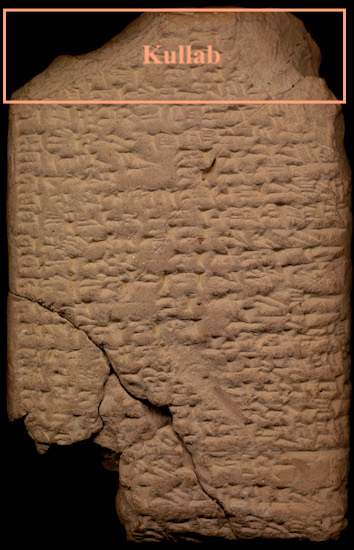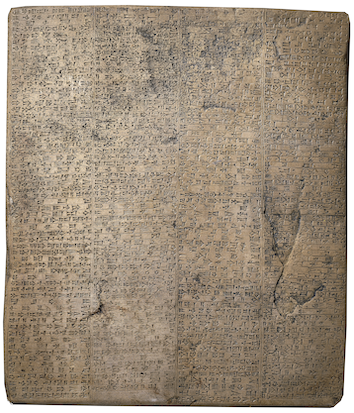Ekišnugal (temple of Sîn at Babylon)
Ekišnugal (also called Egišnugal) was one of the four religious buildings in the Kullab district of East Babylon, at least according to Tablet IV of the scholarly compendium Tintir = Babylon. That temple was dedicated to the moon-god Sîn. This still-to-be-discovered temple had a long history. It is first mentioned in the fifth year of the Old Babylonian king Sūmû-abum and last mentioned in an Astronomical Dairy entry for the year 133 BC. In addition to Ekišnugal, the moon-god had a second (and lesser important temple) in the Eridu district of East Babylon: Enitena.

Names and Spellings
This temple at Babylon went by the Sumerian ceremonial name Ekišnugal, which means "House of Great Light." In a text explaining the names of the temples in Babylon, the Sumerian names Ekišnugal and its alternate form Egišnugal are explained respectively as Akkadian bītu nāṣir kiššat nišī ("House, Guard of All of the People") and bīt nūr šamê rabûti ("House of the Light of the Great Heavens"). The two different orthographic traditions of the name date back to the Early Dynastic Period (early third millennium BC).
- Written Forms: e₂-giš-nu-gal; e₂-giš-nu₁₁-gal; e₂-giš-nu₁₁-gal -u; e₂-kiš-nu₁₁-gal; e₂-kiš-nu-gal₂; e₂-kiš-nun-gal.KI.
Known Builders
- Old Babylonian (ca. 1900–1600 BC)
- Sūmû-abum (r. 1894–1881 BC)
- Abī-ešuh (r. 1711–1684 BC)
- Neo-Babylonian (ca. 625–539 BC)
- Nebuchadnezzar II (r. 604–562 BC)
Building History
Ekišnugal is first attested in year names of the kings of the First Dynasty of Babylon (ca. 1894–1595 BC), when at least two of its kings rebuilt it. Sūmû-abum, the first ruler of the dynasty, (re)built the moon-god's temple during his fifth regnal year (ca. 1889 BC) and Abī-ešuh, the eighth king of that dynastic line, renovated that religious structure sometime during his twenty-eight-year reign. Moreover, Hammu-rāpi (r. 1792–1750 BC) and his immediate successor Samsu-iluna (r. 1749–1712 BC), respectively the sixth and seventh kings of the First Dynasty of Babylon, also patronized this temple at Babylon. Both rulers are known to have dedicated objects to its cult.

BM 129397, a large stone tablet that bears a long Akkadian inscription that is now commonly referred to as the "East India House Inscription." The description of Nebuchadnezzar's rebuilding of Ekišnugal (Egišnugal) is recorded in lines iv 25–28. Image adapted from the British Museum Collection website. Credit: Trustees of the British Museum.
After a gap of approximately 1080 years, information about the building history of Ekišnugal (Egišnugal) resumes during the reign of the Neo-Babylonian king Nebuchadnezzar II, the king who transformed Babylon into an imperial megacity. A handful of Akkadian inscriptions of his, including one written on a large stone tablet (the so-called "East India House Inscription"), record that he rebuilt this temple of Sîn at Babylon. None of the texts, however, provide any details about that project.
Although Ekišnugal was in use until at least 133 BC, nothing is known about its building history after Nebuchadnezzar II's reign. The temple is mentioned in a Babylonian Chronicle concerning the Seleucid ruler Antiochus I Soter (r. 281–261 BC) while he was heir designate. Antiochus is said to have providing offerings to the moon-god in Ekišnugal, as well as in his other temple at Babylon (Enitena).
Archaeological Remains
Ekišnugal has not yet been positively identified in the archaeological record.
Further Reading
- George, A.R. 1992. Babylonian Togographical Texts (Orientalia Lovaniensia Analecta 40), Leuven, pp. 319–320.
- George, A.R. 1993. House Most High. The Temples of Ancient Mesopotamia (Mesopotamian Civilizations 5), Winona Lake, p. 114 no. 654.
- Pedersén, O. 2021. Babylon: The Great City, Münster, p. 198.
Jamie Novotny & Joshua Meynell
Jamie Novotny & Joshua Meynell, 'Ekišnugal (temple of Sîn at Babylon)', Babylonian Temples and Monumental Architecture online (BTMAo), The BTMAo Project, a sub-project of MOCCI, [http://oracc.org/btmao/Babylon/TemplesandZiggurat/Ekishnugal/]